2018 Code2seqGeneratingSequencesfrom
- (Alon et al., 2018) ⇒ Uri Alon, Shaked Brody, Omer Levy, and Eran Yahav. (2018). “code2seq: Generating Sequences from Structured Representations of Code.” In: Proceedings of the 7th International Conference on Learning Representations (ICLR 2019).
Subject Headings: code2seq Network, Abstract Syntax Tree (AST), Automatic Code Summarization, Automatic Code Documentation, Automatic Code Retrieval, Automatic Code Generation, Automatic Code Captioning.
Notes
- Article Version(s):
- Online Resource(s):
Cited By
- Google Scholar: ~ 149 Citations, Retrieved: 2021-02-20.
Quotes
Abstract
The ability to generate natural language sequences from source code snippets has a variety of applications such as code summarization, documentation, and retrieval.
Sequence-to-sequence (seq2seq) models, adopted from neural machine translation (NMT), have achieved state-of-the-art performance on these tasks by treating source code as a sequence of tokens.
We present code2seq: an alternative approach that leverages the syntactic structure of programming languages to better encode source code.
Our model represents a code snippet as the set of compositional paths in its abstract syntax tree (AST) and uses attention to select the relevant paths while decoding.
We demonstrate the effectiveness of our approach for two tasks, two programming languages, and four datasets of up to 16M examples.
Our model significantly outperforms previous models that were specifically designed for programming languages, as well as general state-of-the-art NMT models.
An interactive online demo of our model is available at http://code2seq.org.
Our code, data and trained models are available at http://github.com/tech-srl/code2seq.
1. Introduction
Modeling the relation between source code and natural language can be used for automatic code summarization (Allamanis et al., 2016), documentation (Iyer et al., 2016), retrieval (Allamanis et al., 2015b), and even generation (Balog et al., 2017; Rabinovich et al., 2017; Yin and Neubig, 2017; Devlin et al., 2017; Murali et al., 2017; Brockschmidt et al., 2019). In this work, we consider the general problem of generating a natural language sequence from a given snippet of source code.
A direct approach is to frame the problem as a machine translation problem, where the source sentence is the sequence of tokens in the code and the target sentence is a corresponding natural language sequence. This approach allows one to apply state-of-the-art neural machine translation (NMT) models from the sequence-to-sequence (seq2seq) paradigm (Sutskever et al., 2014; Cho et al., 2014; Bahdanau et al., 2015; Luong et al., 2015; Vaswani et al., 2017), yielding state-of-the-art performance on various code captioning and documentation benchmarks (Iyer et al., 2016; Allamanis et al., 2016; Loyola et al., 2017) despite having extremely long source sequences.
We present an alternative approach for encoding source code that leverages the syntactic structure of programming languages: CODE2SEQ. We represent a given code snippet as a set of compositional paths over its abstract syntax tree (AST), where each path is compressed to a fixed-length vector using LSTMs (Hochreiter and Schmidhuber, 1997). During decoding, CODE2SEQ attends over a different weighted average of the path-vectors to produce each output token, much like NMT models attend over token representations in the source sentence.
We show the effectiveness of our code2seq model on two tasks: (1) code summarization (Figure 1a), where we predict a Java method's name given its body, and (2) code captioning (Figure 1b), where we predict a natural language sentence that describes a given C# snippet.

|
On both tasks, our CODE2SEQ model outperforms models that were explicitly designed for code, such as the model of Allamanis et al. (2016) and CodeNN (Iyer et al., 2016), as well as TreeLSTMs (Tai et al., 2015) and state-of-the-art NMT models (Luong et al., 2015; Vaswani et al., 2017). To examine the importance of each component of the model, we conduct a thorough ablation study. In particular, we show the importance of structural encoding of code, by showing how our model yields a significant improvement over an ablation that uses only token-level information without syntactic paths. To the best of our knowledge, this is the first work to directly use paths in the abstract syntax tree for end-to-end generation of sequences.
2. Representing Code as AST Paths
An Abstract Syntax Tree (AST) uniquely represents a source code snippet in a given language and grammar. The leaves of the tree are called terminals, and usually refer to user-defined values which represent identifiers and names from the code. The non-leaf nodes are called nonterminals and represent a restricted set of structures in the language, e.g., loops, expressions, and variable declarations. For example, Figure 2c shows a partial AST for the code snippet of Figure 2a. Names (such as num) and types (such as int) are represented as values of terminals; syntactic structures such as variable declaration(VarDec) and a do-while loop (DoStmt) are represented as nonterminals.

|

|
Given the AST of a code snippet, we consider all pairwise paths between terminals, and represent them as sequences of terminal and nonterminal nodes. We then use these paths with their terminals' values to represent the code snippet itself. For example, consider the two Java methods of Figure 2. Both of these methods count occurrences of a character in a string. They have exactly the same functionality, although a different implementation, and therefore different surface forms. If these snippets are encoded as sequences of tokens, the recurring patterns that suggest the common method name might be overlooked. However, a structural observation reveals syntactic paths that are common to both methods, and differ only in a single node of a Do-while statement versus a For statement. This example shows the effectiveness of a syntactic encoding of code. Such an encoder can generalize much better to unseen examples because the AST normalizes a lot of the surface form variance. Since our encoding is compositional, the encoder can generalize even if the paths are not identical (e.g., a For node in one path and a While in the other).
Since a code snippet can contain an arbitrary number of such paths, we sample $k$ paths as the representation of the code snippet. To avoid bias, $k$ new paths are sampled afresh in every training iteration. In Section 5 we show that this runtime-sampling provides regularization and improves results compared to sampling the same $k$ paths for each example in advance.
Formally, we use $\mathcal{C}$ to denote a given snippet of code. Every training iteration, $k$ pairs of terminals are uniformly sampled from within the AST of $\mathcal{C}$. Each pair of terminals $\left(v^i_1 , v^i_{l_i}\right)$ implies a single path between them: $v^i_1, v^i_2 \cdots v^i_{l_i}$ . Finally, the input code example is represented as a set of these $k$ random AST paths: $\{\left(v^1_1 v^1_2 \cdots v^1_{l_1}\right), \cdots, \left(v^k_1 v^k_2 \cdots v^k_{l_k}\right)\}, where $l_j$ is the length of the $j$th path.
3. Model Architecture
Our model follows the standard encoder-decoder architecture for NMT (Section 3.1), with the significant difference that the encoder does not read the input as a flat sequence of tokens. Instead, the encoder creates a vector representation for each AST path separately (Section 3.2). The decoder then attends over the encoded AST paths (rather than the encoded tokens) while generating the target sequence. Our model is illustrated in Figure 3.
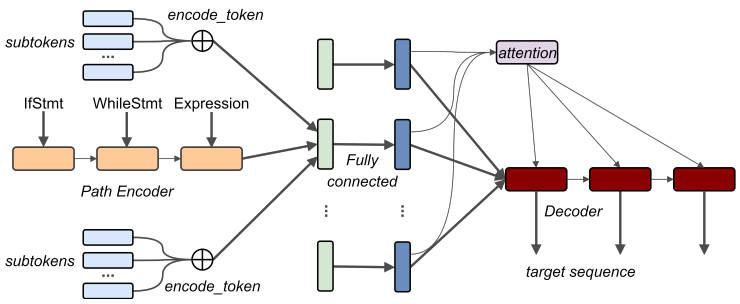
|
3.1 Encoder-Decoder Framework
Contemporary NMT models are largely based on an encoder-decoder architecture (Cho et al., 2014; Sutskever et al., 2014; [Luong et al., 2015; Bahdanau et al., 2015), where the encoder maps an input sequence of tokens $\mathbf{x}=\left(x_{1}, \ldots, x_{n}\right)$ to a sequence of continuous representations $\mathbf{z}=\left(z_{1}, \ldots, z_{n}\right)$. Given $\mathbf{z}$, the decoder then generates a sequence of output tokens $\mathbf{y}=\left(y_{1}, \ldots,y_{n}\right)$ one token at a time, hence modeling the conditional probability: $p\left(y_{1}, \ldots, y_{m} \mid x_{1}, \ldots, x_{n}\right)$.
At each decoding step, the probability of the next target token depends on the previously generated token, and can therefore be factorized as:
$p\left(y_{1}, \ldots, y_{m} \mid x_{1}, \ldots, x_{n}\right)=\prod_{j=1}^{m} p\left(y_{j} \mid y_{<j}, z_{1}, \ldots, z_{n}\right)$
In attention-based models, at each time step $t$ in the decoding phase, a context vector $c_t$ is computed by attending over the elements in $\mathbf{z}$ using the decoding state $h_t$, typically computed by an LSTM.
$\boldsymbol{\alpha}^{t}=\operatorname{softmax}\left(h_{t} W_{a} \boldsymbol{z}\right) \quad c_{t}=\sum_{i}^{n} \alpha_{i}^{t} z_{i}$
The context vector $c_t$ and the decoding state $h_t$ are then combined to predict the current target token $y_t$. Previous work differs in the way the context vector is computed and in the way it is combined with the current decoding state. A standard approach (Luong et al., 2015) is to $c_t$ and $h_t$ through a multi-layer perceptron (MLP) and then predict the probability of the next token using softmax:
$p\left(y_{t} \mid y_{<t}, z_{1}, \ldots, z_{n}\right)=\operatorname{softmax}\left(W_{s} \tanh \left(W_{c}\left[c_{t} ; h_{t}\right]\right)\right)$
3.2 AST Encoder
Given a set of AST paths $\{x_1,\ldots, x_k\}$, our goal is to create a vector representation $z_i$ for each path $x_i = v^i_1 v^i_2 \ldots v^i_{l_i}$. We represent each path separately using a bi-directional LSTM to encode the path, and sub-token embeddings to capture the compositional nature of the terminals' values (the tokens).
Path Representation
Each AST path is composed of nodes and their child indices from a limited vocabulary of up to 364 symbols. We represent each node using a learned embedding matrix$E^{nodes}$ and then encode the entire sequence using the final states of a bi-directional LSTM:
$\begin{array}{c} h_{1}, \ldots, h_{l}=L S T M\left(E_{v_{1}}^{\text {nodes }}, \ldots, E_{v_{l}}^{\text {nodes }}\right) \\ \text { encode }_{-} \operatorname{path}\left(v_{1} \ldots v_{l}\right)=\left[h_{l} ; h_{1}^{\leftarrow}\right] \end{array}$
Token Representation
The first and last node of an AST path are terminals whose values are tokens in the code. Following Allamanis et al. (2015a; 2016), we split code tokens into subtokens; for example, a token with the value ArrayList will be decomposed into Array and List. This is somewhat analogous to byte-pair encoding in NMT (Sennrich et al., 2016), although in the case of programming languages, coding conventions such as camel notation provide us with an explicit partition of each token. We use a learned embedding matrix $E^{subtokens}$ to represent each subtoken, and then sum the subtoken vectors to represent the full token:
$\text { encode_token }(w)=\sum_{s \in \text { split }(w)} E_{s}^{s u b t o k e n s}$
The LSTM decoder may also predict subtokens at each step (e.g. when generating method names), although the decoder's subtoken embedding matrix will be different.
Combined Representation
To represent the path $x = v_1 \ldots v_l$ , we concatenate the path's representation with the token representations of each terminal node, and apply a fully-connected layer:
$z=\tanh \left(W_{\text {in }}\left[\text { encode_path }\left(v_{1} \ldots v_{l}\right) ; \text { encode_token }\left(\text { value }\left(v_{1}\right)\right) ; \text { encode_token }\left(\text { value }\left(v_{l}\right)\right)\right]\right)$
where value is the mapping of a terminal node to its associated value, and $W_{in}$ is a $\left(2d_{path} + 2d_{token}\right) \times d_{hidden}$ matrix.
Decoder Start State
To provide the decoder with an initial state, we average the combined representations of all the $k$ paths in the given example:
$h_{0}=\frac{1}{k} \sum_{i=1}^{k} z_{i}$
Unlike typical encoder-decoder models, the order of the input random paths is not taken into account. Each path is encoded separately and the combined representations are aggregated with mean pooling to initialize the decoder's state. This represents the given source code as a set of random paths.
Attention
Finally, the decoder generates the output sequence while attending over all of the combined representations $z_1,\ldots, z_k$, similarly to the way that seq2seq models attend over the source symbols. The attention mechanism is used to dynamically select the distribution over these $k$ combined representations while decoding, just as an NMT model would attend over the encoded source tokens.
4. Experiments
We evaluate our model on two code-to-sequence tasks: summarization (Section 4.1), in which we predict Java methods' names from their bodies, and captioning (Section 4.2), where we generate natural language descriptions of C# code snippets. Although out of the focus of this work, in Section 4.3 we show that our model also generates Javadocs more accurately than an existing work. We thus demonstrate that our approach can produce both method names and natural language outputs, and can encode a code snippet in any language for which an AST can be constructed (i.e., a parser exists).
Setup The values of all of the parameters are initialized using the initialization heuristic of Glorot and Bengio (2010). We optimize the cross-entropy loss (Rubinstein, 1999; 2001) with a Nesterov momentum (Nesterov, 1983) of 0.95 and an initial learning rate of 0.01, decayed by a factor of 0.95 every epoch. For the Code Summarization task, we apply dropout (Srivastava et al., 2014) of 0.25 on the input vectors $x_j$, and 0.7 for the Code Captioning task because of the smaller number of examples in the C# dataset. We apply a recurrent dropout of 0.5 on the LSTM that encodes the AST paths. We used $d_{tokens} = d_{nodes} = d_{hidden} = d_{target} = 128$. For the Code Summarization task, each LSTM that encodes the AST paths had 128 units and the decoder LSTM had 320 units. For the Code Captioning task, to support the longer target sequences, each encoder LSTM had 256 units and the decoder was of size 512.
Choice of k We experimented with different values of $k$, the number of sampled paths from each example (which we set to 200 in the final models). Lower values than $k = 100$ showed worse results, and increasing to $k > 300$ did not result in consistent improvement. In practice, $k = 200$ was found to be a reasonable sweet spot between capturing enough information while keeping training feasible in the GPU's memory. Additionally, since the average number of paths in our Java-large training set is 220 paths per example, a number as high as 200 is beneficial for some large methods.
4.1 Code Summarization
In this task, we predict a Java method's name given its body. As was previously observed (Allamanis et al., 2016; Alon et al., 2019), this is a good benchmark because a method name in open-source Java projects tends to be succinct and precise, and a method body is often a complete logical unit. We predict the target method name as a sequence of sub-tokens, e.g., setMaxConnectionsPerServer is predicted as the sequence "set max connections per server". The target sequence length is about 3 on average. We adopt the measure used by Allamanis et al. (2016) and Alon et al. (2019), who measured precision, recall, and F1 score over the target sequence, case insensitive.
Data
We experiment with this task across three datasets. In these datasets, we always train across multiple projects and predict on distinct projects:
- Java-small – Contains 11 relatively large Java projects, originally used for 11 distinct models for training and predicting within the scope of the same project (Allamanis et al., 2016). We use the same data, but train and predict across projects: we took 9 projects for training, 1 project for validation and 1 project as our test set. This dataset contains about 700K examples.
- Java-med – A new dataset of the 1000 top-starred Java projects from GitHub. We randomly select 800 projects for training, 100 for validation and 100 for testing. This dataset contains about 4M examples and we make it publicly available.
- Java-large – A new dataset of the 9500 top-starred Java projects from GitHub that were created since January 2007. We randomly select 9000 projects for training, 250 for validation and 300 for testing. This dataset contains about 16M examples and we make it publicly available.
More statistics of our datasets can be found in Appendix A.
Baselines
We re-trained all of the baselines on all of the datasets of this task using the original implementations of the authors. We compare CODE2SEQ to the following baselines: Allamanis et al. (2016), who used a convolutional attention network to predict method names; syntactic paths with Conditional Random Fields (CRFs) (Alon et al., 2018); code2vec (Alon et al., 2019); and a TreeLSTM (Tai et al., 2015) encoder with an LSTM decoder and attention on the input sub-trees. Additionally, we compared to three NMT baselines that read the input source code as a stream of tokens: 2-layer bidirectional encoder-decoder LSTMs (split tokens and full tokens) with global attention (Luong et al., 2015), and the Transformer (Vaswani et al., 2017), which achieved state-of-the-art results for translation tasks.
We put significant effort into strengthening the NMT baselines in order to provide a fair comparison: (1) we split tokens to subtokens, as in our model (e.g., HashSet → Hash Set) – this was shown to improve the results by about 10 F1 points (Table 1); (2) we deliberately kept the original casing of the source tokens since we found it to improve their results; and (3) during inference, we replaced generated UNK tokens with the source tokens that were given the highest attention. For the 2-layer BiLSTM we used embeddings of size 512, an encoder and a decoder of 512 units each, and the default hyperparameters of OpenNMT (Klein et al., 2017). For the Transformer, we used their original hyperparameters (Vaswani et al., 2017). This resulted in a Transformer model with 169M parameters and a BiLSTM model with 134M parameters, while our code2seq model had only 37M[1].
| Model | Java-small | Java-med | Java-large | ||||||
|---|---|---|---|---|---|---|---|---|---|
| Prec | Rec | F1 | Prec | Rec | F1 | Prec | Rec | F1 | |
| ConvAttention (Allamanis et al.,2016) | 50.25 | 24.62 | 33.05 | 60.82 | 26.75 | 37.16 | 60.71 | 27.60 | 37.95 |
| Paths+CRFs (Alon et al.,2018) | 8.39 | 5.63 | 6.74 | 32.56 | 20.37 | 25.06 | 32.56 | 20.37 | 25.06 |
| code2vec (Alon et al., 2019) | 18.51 | 18.74 | 18.62 | 38.12 | 28.31 | 32.49 | 48.15 | 38.40 | 42.73 |
| 2-layer BiLSTM (no token splitting) | 32.40 | 20.40 | 25.03 | 48.37 | 30.29 | 37.25 | 58.02 | 37.73 | 45.73 |
| 2-layer BiLSTM | 42.63 | 29.97 | 35.20 | 55.15 | 41.75 | 47.52 | 63.53 | 48.77 | 55.18 |
| TreeLSTM (Tai et al., 2015) | 40.02 | 31.84 | 35.46 | 53.07 | 41.69 | 46.69 | 60.34 | 48.27 | 53.63 |
| Transformer (Vaswani et al., 2017) | 38.13 | 26.70 | 31.41 | 50.11 | 35.01 | 41.22 | 59.13 | 40.58 | 48.13 |
| code2seq | 50.64 | 37.40 | 43.02 | 61.24 | 47.07 | 53.23 | 64.03 | 55.02 | 59.19 |
| Absolute gain over BiLSTM | +8.01 | +7.43 | +7.82 | +6.09 | +5.32 | +5.71 | +0.50 | +6.25 | +4.01 |
Performance
Table 1 shows the results for the code summarization task. Our model significantly outperforms the baselines in both precision and recall across all three datasets, demonstrating that there is added value in leveraging ASTs to encode source code. Our model improves over the best baselines, BiLSTM with split tokens, by between 4 to 8 F1 points on all benchmarks. BiLSTM with split tokens consistently scored about 10 F1 points more than BiLSTM with full tokens, and for this reason we included only the split token Transformer and TreeLSTM baselines. Our model outperforms ConvAttention (Allamanis et al., 2016), which was designed specifically for this task; Paths + CRFs (Alon et al., 2018), which used syntactic features; and TreeLSTMs. Although TreeLSTMs also leverage syntax, we hypothesize that our syntactic paths capture long distance relationships while TreeLSTMs capture mostly local properties. An additional comparison to code2vec on the code2vec dataset can be found in Appendix A. Examples for predictions made by our model and each of the baselines can be found in Appendix C and at http://code2seq.org.
Fernandes et al. (2019) encoded code using Graph Neural Networks (GNN), and reported lower performance than our model on Java-large without specifying the exact F1 score. They report slightly higher results than us on Java-small only by extending their GNN encoder with a subtoken-LSTM (BILSTM + GNN → LSTM); by extending the Transformer with GNN (SELFATT + GNN → SELFATT); or by extending their LSTM decoder with a pointer network (GNN → LSTM + POINTER). All these extensions can be incorporated into our model as well.
Data Efficiency
ConvAttention (Allamanis et al., 2016) performed even better than the Transformer on the Java-small dataset, but could not scale and leverage the larger datasets. Paths + CRFs showed very poor results on the Java-small dataset, which is expected due to the sparse nature of their paths and the CRF model. When compared to the best among the baselines (BiLSTM with split tokens), our model achieves a relative improvement of 7.3% on Java-large, but as the dataset becomes smaller, the larger the relative difference becomes: 13% on Java-med and 22% on Java-small; when compared to the Transformer, the relative improvement is 23% on Java-large and 37% on Java-small. These results show the data efficiency of our architecture: while the data-hungry NMT baselines require large datasets, our model can leverage both small and large datasets.
Sensitivity to Input Length
We examined how the performance of each model changes as the size of the test method grows. As shown in Figure 4, our model is superior to all examined baselines across all code lengths. All models give their best results for short snippets of code, i.e., less than 3 lines. As the size of the input code increases, all examined models show a natural descent, and show stable results for lengths of 9 and above.
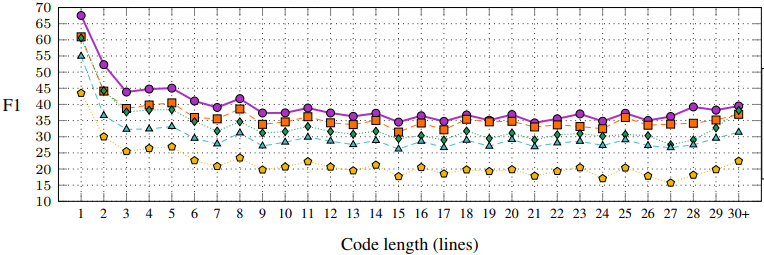
|
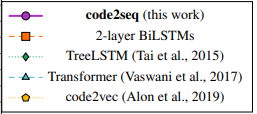
|
4.2 Code Captioning
For this task we consider predicting a full natural language sentence given a short C# code snippet. We used the dataset of CodeNN (Iyer et al., 2016), which consists of 66,015 pairs of questions and answers from StackOverflow. They used a semi-supervised classifier to filter irrelevant examples and asked human annotators to provide two additional titles for the examples in the test set, making a total of three reference titles for each code snippet. The target sequence length in this task is about 10 on average. This dataset is especially challenging as it is orders of magnitude smaller than the code summarization datasets. Additionally, StackOverflow code snippets are typically short, incomplete at times, and aim to provide an answer to a very specific question. We evaluated using BLEU score with smoothing, using the same evaluation scripts as Iyer et al. (2016).
Baselines
We present results compared to CodeNN, TreeLSTMs with attention, 2-layer bidirectional LSTMs with attention, and the Transformer. As before, we provide a fair comparison by splitting tokens to subtokens, and replacing UNK during inference. We also include numbers from baselines used by Iyer et al. (2016).
Results
Table 2 summarizes the results for the code captioning task. Our model achieves a BLEU score of 23.04, which improves by 2.51 points (12.2% relative) over CodeNN, whose authors introduced this dataset, and over all the other baselines, including BiLSTMs, TreeLSTMs and the Transformer, which achieved slightly lower results than CodeNN. Examples for predictions made by our model and each of the baselines can be found in Appendix F. These results show that when the training examples are short and contain incomplete code snippets, our model generalizes better to unseen examples than a shallow textual token-level approach, thanks to its syntactic representation of the data. Although TreeLSTMs also represent the data syntactically, the TreeLSTM baseline achieved lower scores.
| Model | BLEU |
|---|---|
| MOSES☨(Koehn et al., 2007) | 11.57 |
| IR☨ | 13.66 |
| SUM-NN☨ (Rush et al., 2015) | 19.31 |
| 2-layer BiLSTM | 19.78 |
| Transformer (Vaswani et al., 2017) | 19.68 |
| TreeLSTM (Tai et al., 2015) | 20.11 |
| CodeNN☨ (Iyer et al., 2016) | 20.53 |
| code2seq | 23.04 |
4.3 Code Documentation
Although the task of generating code documentation is outside the focus of this work, we performed an additional comparison to Hu et al. (2018). They trained a standard seq2seq model by using the linearized AST as the source sequence and a Javadoc natural language sentence as the target sequence. While they originally report a BLEU score of 38.17, we computed their BLEU score using prediction logs provided us by the authors and obtained a BLEU score of 8.97, which we find more realistic. Training our model on the same dataset as Hu et al., matching LSTM sizes, and using the same script on our predictions yields a BLEU score of 14.53, which is a 62% relative gain over the model of Hu et al. (2018). This shows that our structural approach represents code better than linearizing the AST and learning it as a sequence.
5. Ablation Study
To better understand the importance of the different components of our model, we conducted an extensive ablation study. We varied our model in different ways and measured the change in performance. These experiments were performed for the code summarization task, on the validation set of the Java-med dataset. We examined several alternative designs:
- No AST nodes – instead of encoding an AST path using an LSTM, take only the first and last terminal values to construct an input vector.
- No decoder – no sequential decoding; instead, predict the target sequence as a single symbol using a single softmax layer.
- No token splitting – no subtoken encoding; instead, embed the full token.
- No tokens – use only the AST nodes without using the values associated with the terminals.
- No attention – decode the target sequence given the initial decoder state, without attention.
- No random – no re-sampling of $k$ paths in each iteration; instead, sample in advance and use the same $k$ paths for each example throughout the training process.
Table 3 shows the results of these alternatives. As seen, not encoding AST nodes resulted in a degradation especially in the precision: a decrease of 5.16 compared to 4.30 for the recall. It is quite surprising that this ablation was still better than the baselines (Table 1): for example, the Transformer can implicitly capture pairs of tokens using its self-attention mechanism. However, not all tokens are AST leaves. By focusing on AST leaves, we increase the focus on named tokens, and effectively ignore functional tokens like brackets, parentheses, semicolons, etc. Transformers can (in theory) capture the same signal, but perhaps they require significantly more layers or a different optimization to actually learn to focus on those particular elements. The AST gives us this information for free without having to spend more transformer layers just to learn it. Additionally, for practical reasons we limited the length of the paths to 9. This leads to pairs of leaves that are close in the AST, but not necessarily close in the sequence. In contrast, the Transformer's attention is effectively skewed towards sequential proximity because of the positional embeddings.
| Model | Precision | Recall | F1 | ΔF1 |
|---|---|---|---|---|
| code2seq (original model) | 60.67 | 47.41 | 53.23 | |
| No AST nodes (only tokens) | 55.51 | 43.11 | 48.53 | -4.70 |
| No decoder | 47.99 | 28.96 | 36.12 | -17.11 |
| No token splitting | 48.53 | 34.80 | 40.53 | -12.70 |
| No tokens (only AST nodes) | 33.78 | 21.23 | 26.07 | -27.16 |
| No attention | 57.00 | 41.89 | 48.29 | -4.94 |
| No random (sample $k$ paths in advance) | 59.08 | 44.07 | 50.49 | -2.74 |
Using a single prediction with no decoder reduces recall by more than one-third. This shows that the method name prediction task should be addressed as a sequential prediction, despite the methods' relatively short names. Using no token splitting or no tokens at all drastically reduces the score, showing the significance of encoding both subtokens and syntactic paths. Despite the poor results of no tokens, it is still surprising that the model can achieve around half the score of the full model, as using no tokens is equivalent to reasoning about code which has no identifier names, types, APIs, and constant values, which can be very difficult even for a human. The no attention experiment shows the contribution of attention in our model, which is very close in its relative value to the contribution of attention in seq2seq models (Luong et al., 2015; Bahdanau et al., 2015). The no random experiment shows the positive contribution of sampling $k$ different paths afresh on every training iteration, instead of using the same sample of paths from each example during the entire training. This approach provides data-level regularization that further improves an already powerful model. Another visualization can be found in Appendix D.
6. Related Work
The growing availability of open source repositories creates new opportunities for using machine learning to process source code en masse. Several papers model code as a sequence of tokens (Iyer et al., 2016; Allamanis et al., 2016; Loyola et al., 2017), characters (Bielik et al., 2017), and API calls (Raychev et al., 2014). While sometimes obtaining satisfying results, these models treat code as a sequence rather than a tree. This necessitates implicit relearning of the (predefined) syntax of the programming language, wasting resources and reducing accuracy.
Code representation models that use syntactic information have usually been evaluated on relatively easier tasks, which mainly focus on “filling the blanks” in a given program (Alon et al., 2018; Bielik et al., 2016; Raychev et al., 2016; 2015; Allamanis et al., 2018) or semantic classification of code snippets (Alon et al., 2019). Moreover, none of the models that use syntactic relations are compositional, and therefore the number of possible syntactic relations is fixed either before or after training, a process which results in a large RAM and GPU memory consumption. The syntactic paths of Alon et al. (2018; 2019) are represented monolithically, and are therefore limited to only a subset of the paths that were observed enough times during training. As a result, they cannot represent unseen relations. In contrast, by representing AST paths node-by-node using LSTMs, our model can represent and use any syntactic path in any unseen example. Further, our model decodes the output sequence step-by-step while attending over the input paths, and can thus generate unseen sequences, compared to code2vec (Alon et al., 2019), which has a closed vocabulary.
Oda et al. (2015) were the first to generate sequences by leveraging the syntax of code. They performed a line-by-line statistical machine translation (SMT) to translate Python code to pseudocode. Our tasks are different, and we cannot assume an alignment between elements in the input and the output; our tasks take a whole code snippet as their input, and produce a much shorter sequence as output. Additionally, a conceptual advantage of our model over line-by-line translation is its ability to capture multiline patterns in the source code. These multiline patterns are often very useful for the model and get the most attention (Figure 1a). A recent work (Hu et al., 2018) generates comments from code. There is a conceptual difference between our approaches: Hu et al. (2018) linearize the AST, and then pass it on to a standard seq2seq model. We present a new model, in which the encoder already assumes that the input is tree-structured. When training our model on their dataset, we improve over their BLEU score by 62% (Section 4.3).
Allamanis et al. (2018) represent code with Gated Graph Neural Networks. Nodes in the graph represent identifiers, and edges represent syntactic and semantic relations in the code such as “ComputedFrom” and “LastWrite". The edges are designed for the semantics of a specific programming language, for a specific task, and require an expert to devise and implement. In contrast, our model has minimal assumptions on the input language and is general enough not to require either expert semantic knowledge or the manual design of features. Our model can therefore be easily implemented for various input languages. Bastings et al. (2017) used graph-convolutional networks for machine translation of natural languages. Piech et al. (2015) encoded code using Tree-RNNs to propagate feedback on student code; and Chen et al. (2018) used Tree-RNNs for a tree-to-tree translation of code into another programming language.
7. Conclusion
We presented a novel code-to-sequence model which considers the unique syntactic structure of source code with a sequential modeling of natural language. The core idea is to sample paths in the Abstract Syntax Tree of a code snippet, encode these paths with an LSTM, and attend to them while generating the target sequence.
We demonstrate our approach by using it to predict method names across three datasets of varying sizes, predict natural language captions given partial and short code snippets, and to generate method documentation, in two programming languages. Our model performs significantly better than previous programming-language-oriented works and state-of-the-art NMT models applied in our settings.
We believe that the principles presented in this paper can serve as a basis for a wide range of tasks which involve source code and natural language, and can be extended to other kinds of generated outputs. To this end, we make all our code, datasets, and trained models publicly available.
Acknowledgments
We would like to thank Guy Waldman for developing the code2seq website (http://code2seq.org), Srinivasan Iyer for the guidance in using his C# dataset, and Miltiadis Allamanis, Yoav Goldberg, Charles Sutton and the anonymous reviewers for their fruitful comments and suggestions.
The research leading to these results has received funding from the European Union's Seventh Framework Programme (FP7) under grant agreement no. 615688-ERC- COG-PRIME.
A. Additional Evaluation
Comparison to code2vec on their Dataset
We perform an additional comparison to code2vec (Alon et al., 2019) on their proposed dataset. As shown in Table 4, code2vec achieves a high F1 score on that dataset. However, our model achieves an even higher F1 score. The poorer performance of code2vec on our dataset is probably due to its always being split to train/validation /test by project, whereas the dataset of code2vec is split by file. In the code2vec dataset, a file can be in the training set, while another file from the same project can be in the test set. This makes their dataset significantly easier, because method names "leak" to other files in the same project, and there are often duplicates in different files of the same project. This is consistent with Allamanis et al. (2018), who found that splitting by file makes the dataset easier than by project. We decided to take the stricter approach, and not to use their dataset (even though our model achieves better results on it), in order to make all of our comparisons on split-by-project datasets.
| Model | Our Java-large dataset (same as in Table 1) | code2vec dataset (Alon et al., 2019) | ||||
|---|---|---|---|---|---|---|
| Prec | Rec | F1 | Prec | Rec | F1 | |
| code2vec (Alon et al., 2019) | 48.2 | 38.4 | 42.7 | 63.1 | 54.4 | 58.4 |
| code2seq (this work) | 64.0 | 55.02 | 59.2 | 70.2 | 63.3 | 66.6 |
Data Statistics
Table 5 shows some statistics of our used datasets.
| Java-small | Java-med | Java-large | C# (Iyer et al., 2016) | |
|---|---|---|---|---|
| #projects-training | 10 | 800 | 8999 | &mdask; |
| #projects-validation | 1 | 100 | 250 | &mdask; |
| #projects-test | 1 | 96 | 307 | &mdask; |
| #examples-training | 665,115 | 3,004,536 | 15,344,512 | 52,812 |
| #examples-validation | 23,505 | 410,699 | 320,866 | 6,601 |
| # examples-test | 56,165 | 411,751 | 417,003 | 6,602 |
| Avg.number of paths(training) | 171 | 187 | 220 | 207 |
| Avg.codelength-lines (training) | 6.0 | 6.3 | 6.6 | 8.3 |
| Avg.codelength-tokens(training) | 60 | 63 | 65 | 38 |
| Avg.codelength-subtokenized(training) | 75 | 78 | 80 | 67 |
| Avg.target length (training) | 3 | 3 | 3 | 10 |
B. Code Captioning Examples
Figure 6 contains examples from our test set for the code captioning task in C#, along with the prediction of our model and each of the baselines.
Figure 5 shows a timestep-by-timestep example, with the symbol decoded at each timestep and the top-attended path at that step. The width of the path is proportional to the attention it was given by the model (because of space limitations we included only the top-attended path for each decoding step, but hundreds of paths are attended at each step).

|

|

|

|
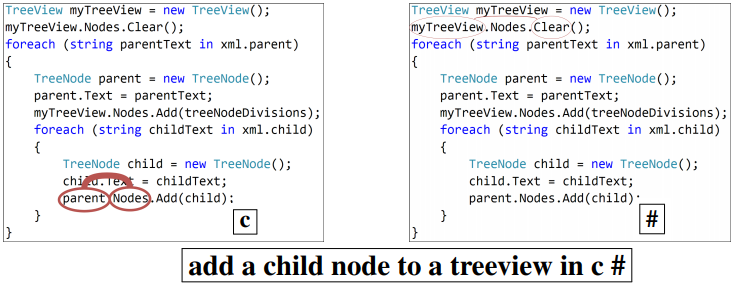
|
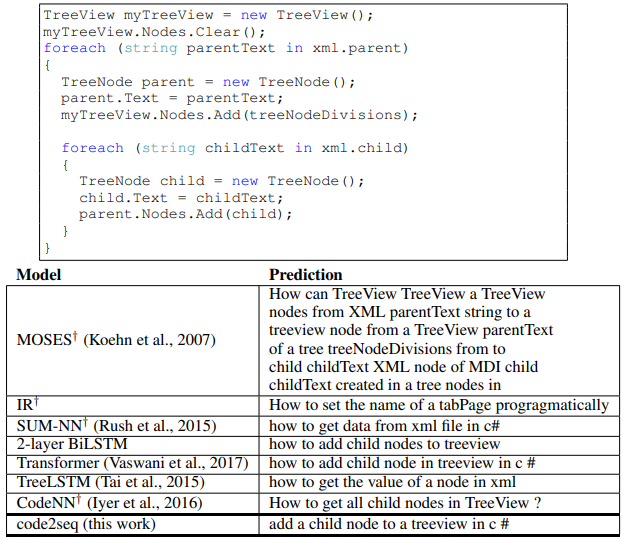
|
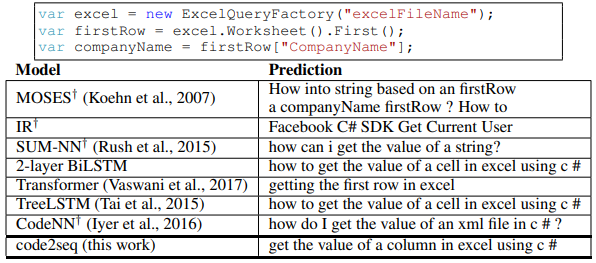
|
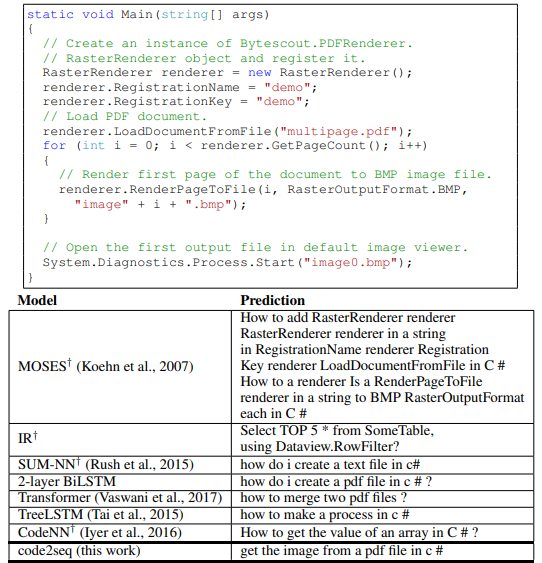
|
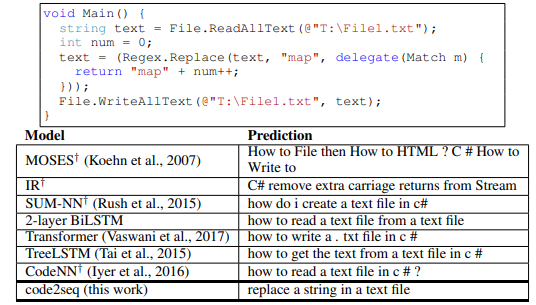
|
C. Code Summarization Examples
Figure 7 contains examples from our test set for the code summarization task in C#, along with the prediction of our model and each of the baselines.
The presented predictions are made by models that were trained on the same Java-large dataset.
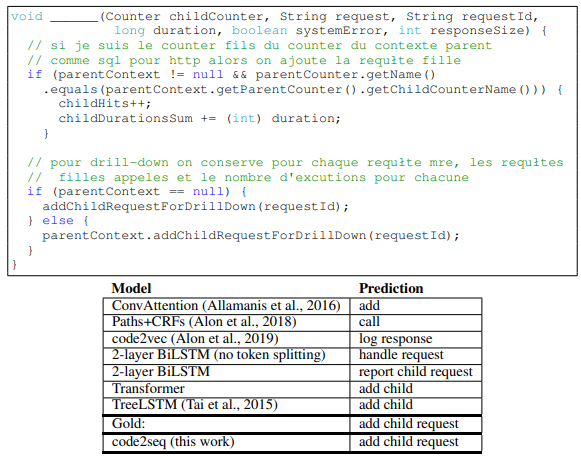
|
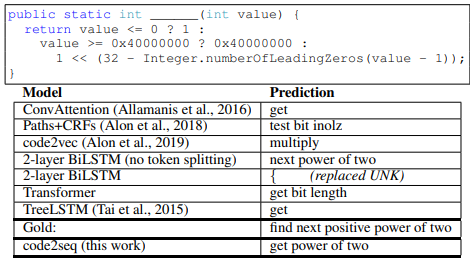
|
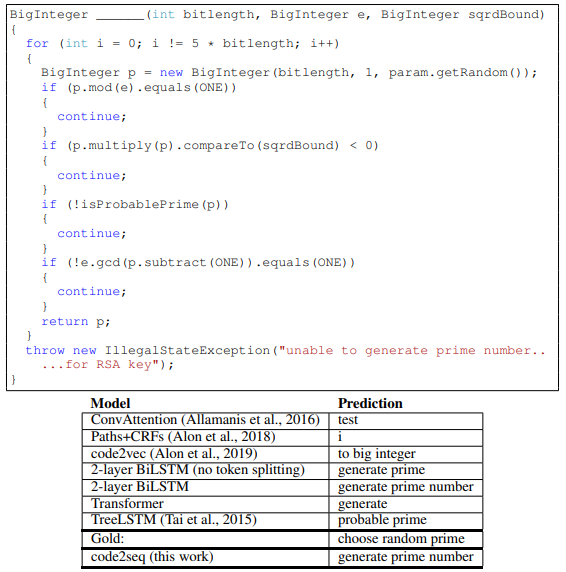
|
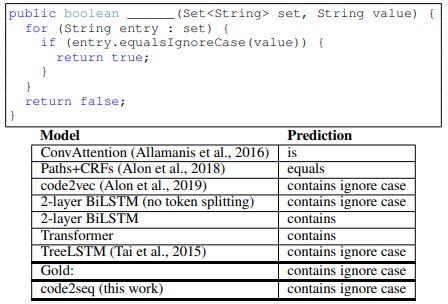
|
D. Code Captioning Results
Figure 8 shows a bar chart of the BLEU score of our model and the baselines, in the code captioning task (predicting natural language descriptions for C# code snippets). The numbers are the same as in Table 2.
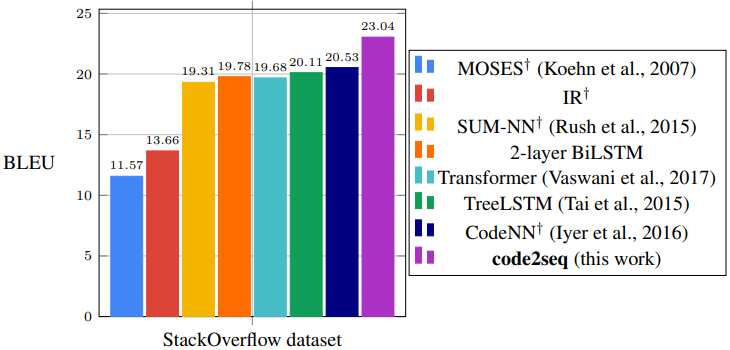
|
E. Code Summarization Results
Figure 9 shows a bar chart of the F1 score of our model and the baselines, in the code summarization task (predicting method names in Java). The numbers are the F1 columns from Table 1.
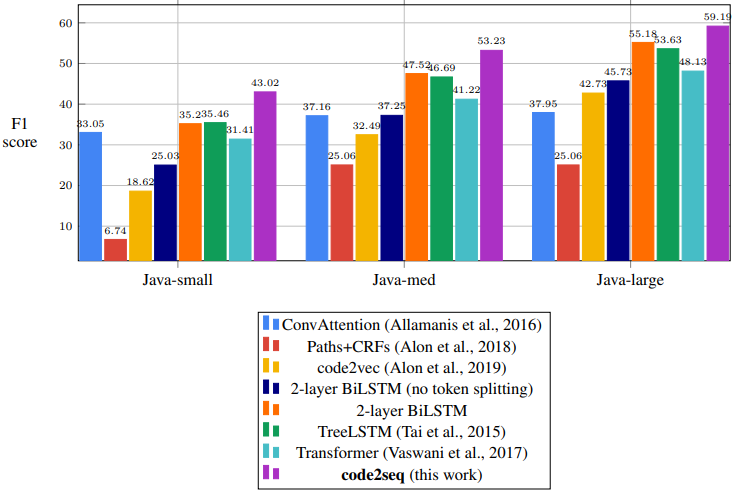
|
F. Ablation Study Results
Figure 10 shows a bar chart of the relative decrease in precision and recall for each of the ablations described in Section 5 and presented in Table 3.
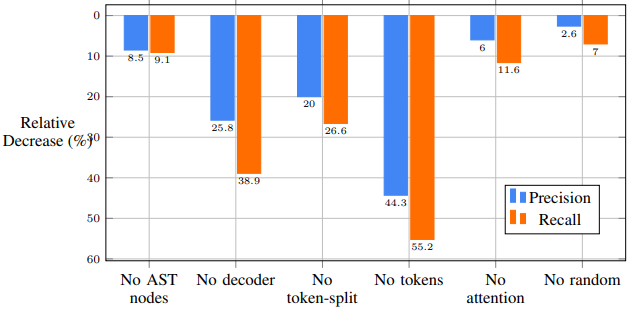
|
Footnotes
- ↑ We also trained versions of the NMT baselines in which we down-matched the sizes and number of parameters to our model. These baselines seemed to benefit from more parameters, so the results reported here are for the versions that had many more parameters than our model.
References
2019a
- (Alon et al., 2019) ⇒ Uri Alon, Meital Zilberstein, Omer Levy, and Eran Yahav. (2019). “code2vec: Learning Distributed Representations of Code.” In: Proceedings of the ACM on Programming Languages (POPL), Volume 3.
2019b
- (Brockschmidt et al., 2019) ⇒ Marc Brockschmidt, Miltiadis Allamanis, Alexander L. Gaunt, and Oleksandr Polozov. Generative code modeling with graphs. In International Conference on Learning Representations, 2019. URL https://openreview.net/forum?id=Bke4KsA5FX.
2019c
- (Fernandes et al., 2019) ⇒ Patrick Fernandes, Miltiadis Allamanis, and Marc Brockschmidt. Structured neural summarization. In International Conference on Learning Representations, 2019. URL https: //openreview.net/forum?id=H1ersoRqtm.
2018a
- (Allamanis et al., 2018) ⇒ Miltiadis Allamanis, Marc Brockschmidt, and Mahmoud Khademi. Learning to represent programs with graphs. In International Conference on Learning Representations, 2018. URL https: //openreview.net/forum?id=BJOFETxR-.
2018b
- (Alon et al., 2018) ⇒ Uri Alon, Meital Zilberstein, Omer Levy, and Eran Yahav. A general path-based representation for predicting program properties. In: Proceedings of the 39th ACM SIGPLAN Conference on Programming Language Design and Implementation, PLDI 2018, pages 404–419, New York, NY, USA, 2018. ACM. ISBN 978-1-4503-5698-5. doi:10.1145/3192366.3192412. URL http: //doi.acm.org/10.1145/3192366.3192412.
2018c
- (Chen et al., 2018) ⇒ Xinyun Chen, Chang Liu, and Dawn Song. Tree-to-tree neural networks for program translation. CoRR, abs/1802.03691, 2018. URL http://arxiv.org/abs/1802.03691.
2018d
- (Hu et al., 2018) ⇒ Xing Hu, Ge Li, Xin Xia, David Lo, and Zhi Jin. Deep code comment generation. In: Proceedings of the 26th Conference on Program Comprehension, pages 200–210. ACM, 2018.
2017a
- (Balog et al., 2017) ⇒ Matej Balog, Alexander L Gaunt, Marc Brockschmidt, Sebastian Nowozin, and Daniel Tarlow. Deepcoder: Learning to write programs. In ICLR, 2017.
2017b
- (Bastings et al., 2017) ⇒ Joost Bastings, Ivan Titov, Wilker Aziz, Diego Marcheggiani, and Khalil Simaan. Graph convolutional encoders for syntax-aware neural machine translation. In: Proceedings of the 2017 Conference on Empirical Methods in Natural Language Processing, pages 1957–1967, Copenhagen, Denmark, September 2017. Association for Computational Linguistics. URL https: //www.aclweb.org/anthology/D17-1209.
2017c
- (Bielik et al., 2017) ⇒ Pavol Bielik, Veselin Raychev, and Martin Vechev. Program synthesis for character level language modeling. In ICLR, 2017.
2017d
- (Devlin et al., 2017) ⇒ Jacob Devlin, Jonathan Uesato, Surya Bhupatiraju, Rishabh Singh, Abdel-rahman Mohamed, and Pushmeet Kohli. Robustfill: Neural program learning under noisy i/o. In International Conference on Machine Learning, pages 990–998, 2017.
2017e
- (Klein et al., 2017) ⇒ Guillaume Klein, Yoon Kim, Yuntian Deng, Jean Senellart, and Alexander M. Rush. (2017)."OpenNMT: Open-Source Toolkit for Neural Machine Translation". In: Proceedings of the 55th Annual Meeting of the Association for Computational Linguistics (ACL 2017) System Demonstrations.
2017f
- (Loyola et al., 2017) ⇒ Pablo Loyola, Edison Marrese-Taylor, and Yutaka Matsuo. A neural architecture for generating natural language descriptions from source code changes. In: Proceedings of the 55th Annual Meeting of the Association for Computational Linguistics (Volume 2: Short Papers), pages 287– 292. Association for Computational Linguistics, 2017. doi:10.18653/v1/P17-2045. URL http: //www.aclweb.org/anthology/P17-2045.
2017g
- (Murali et al., 2015) ⇒ Vijayaraghavan Murali, Swarat Chaudhuri, and Chris Jermaine. Bayesian sketch learning for program synthesis. CoRR, abs/1703.05698, 2017. URL http://arxiv.org/abs/1703. 05698.
2017h
- (Rabinovich et al., 2017) ⇒ Maxim Rabinovich, Mitchell Stern, and Dan Klein. Abstract syntax networks for code generation and semantic parsing. In: Proceedings of the 55th Annual Meeting of the Association for Computational Linguistics (Volume 1: Long Papers), pages 1139–1149. Association for Computational Linguistics, 2017. doi:10.18653/v1/P17-1105. URL http://www.aclweb.org/ anthology/P17-1105.
2017i
- (Vaswani et al., 2017) ⇒ Ashish Vaswani, Noam Shazeer, Niki Parmar, Jakob Uszkoreit, Llion Jones, Aidan N Gomez, Łukasz Kaiser, and Illia Polosukhin. (2017). “Attention is all You Need.” In: Advances in Neural Information Processing Systems.
2017j
- (Yin & Neubig, 2017) ⇒ Pengcheng Yin and Graham Neubig. A syntactic neural model for general-purpose code generation. In: Proceedings of the 55th Annual Meeting of the Association for Computational Linguistics (Volume 1: Long Papers), pages 440–450. Association for Computational Linguistics, 2017. doi:10.18653/v1/P17-1041. URL http://www.aclweb.org/anthology/P17-1041.
2016a
- (Allamanis et al., 2016) ⇒ Miltiadis Allamanis, Hao Peng, and Charles A. Sutton. A convolutional attention network for extreme summarization of source code. In: Proceedings of the 33nd International Conference on Machine Learning, ICML 2016, New York City, NY, USA, June 19-24, 2016, pages 2091–2100, 2016. URL http://jmlr.org/proceedings/papers/v48/allamanis16.html.
2016b
- (Bielik et al., 2016) ⇒ Pavol Bielik, Veselin Raychev, and Martin T. Vechev. PHOG: probabilistic model for code. In: Proceedings of the 33nd International Conference on Machine Learning, ICML 2016, New York City, NY, USA, June 19-24, 2016, pages 2933–2942, 2016. URL http://jmlr.org/proceedings/papers/v48/bielik16.html.
2016c
- (Iyer et al., 2016) ⇒ Srinivasan Iyer, Ioannis Konstas, Alvin Cheung, and Luke Zettlemoyer. (2016). “Summarizing Source Code Using a Neural Attention Model.” In: Proceedings of the 54th Annual Meeting of the Association for Computational Linguistics (ACL 2016) Volume 1: Long Papers.
2016d
- (Raychev et al., 2016) ⇒ Veselin Raychev, Pavol Bielik, and Martin Vechev. Probabilistic model for code with decision trees. In: Proceedings of the 2016 ACM SIGPLAN International Conference on Object-Oriented Programming, Systems, Languages, and Applications, OOPSLA 2016, pages 731–747, New York, NY, USA, 2016. ACM. ISBN 978-1-4503-4444-9. doi:10.1145/2983990.2984041. URL http://doi.acm.org/10.1145/2983990.2984041.
2016e
- (Sennrich et al., 2016) ⇒ Rico Sennrich, Barry Haddow, and Alexandra Birch. (2016). “Neural Machine Translation of Rare Words with Subword Units.” In: Proceedings of the 54th Annual Meeting of the Association for Computational Linguistics (ACL-2016).
2015a
- (Allamanis et al., 2015a) ⇒ Miltiadis Allamanis, Earl T. Barr, Christian Bird, and Charles Sutton. Suggesting accurate method and class names. In: Proceedings of the 2015 10th Joint Meeting on Foundations of Software Engineering, ESEC/FSE 2015, pages 38–49, New York, NY, USA, 2015a. ACM. ISBN 978- 1-4503-3675-8. doi:10.1145/2786805.2786849. URL http://doi.acm.org/10.1145/ 2786805.2786849.
2015b
- (Allamanis et al., 2015b) ⇒ Miltiadis Allamanis, Daniel Tarlow, Andrew D. Gordon, and Yi Wei. Bimodal Modelling of Source Code and Natural Language. In: Proceedings of the 32nd International Conference on Machine Learning, volume 37 of JMLR Proceedings, pages 2123–2132. JMLR.org, 2015b.
2015c
- (Bahdanau et al., 2015) ⇒ Dzmitry Bahdanau, Kyunghyun Cho, and Yoshua Bengio. (2015). “Neural Machine Translation by Jointly Learning to Align and Translate.” In: Proceedings of the Third International Conference on Learning Representations, (ICLR-2015).
2015d
- (Luong, Pham et al., 2015) ⇒ Minh-Thang Luong, Hieu Pham, and Christopher D. Manning. (2015). “Effective Approaches to Attention-based Neural Machine Translation". In: Proceedings of Conference on Empirical Methods in Natural Language Processing (EMNLP-2015).
2015e
- (Oda et al., 2015) ⇒ Yusuke Oda, Hiroyuki Fudaba, Graham Neubig, Hideaki Hata, Sakriani Sakti, Tomoki Toda, and Satoshi Nakamura. Learning to generate pseudo-code from source code using statistical machine translation (t). In Automated Software Engineering (ASE), 2015 30th IEEE/ACM International Conference on, pages 574–584. IEEE, 2015.
2015f
- (Piech et al., 2015) ⇒ Chris Piech, Jonathan Huang, Andy Nguyen, Mike Phulsuksombati, Mehran Sahami, and Leonidas Guibas. Learning program embeddings to propagate feedback on student code. In: Proceedings of the 32Nd International Conference on International Conference on Machine Learning - Volume 37, ICML’15, pages 1093–1102. JMLR.org, 2015. URL http://dl.acm.org/citation. cfm?id=3045118.3045235.
2015g
- (Raychev et al., 2015) ⇒ Veselin Raychev, Martin Vechev, and Andreas Krause. Predicting program properties from ”big code”. In: Proceedings of the 42Nd Annual ACM SIGPLAN-SIGACT Symposium on Principles of Programming Languages, POPL ’15, pages 111–124, New York, NY, USA, 2015. ACM. ISBN 978-1-4503-3300-9. doi:10.1145/2676726.2677009. URL http://doi.acm.org/ 10.1145/2676726.2677009.
2015h
- (Rush et al., 2015) ⇒ Alexander M. Rush, Sumit Chopra, and Jason Weston. (2015). “A Neural Attention Model for Abstractive Sentence Summarization.” In: Proceedings of the 2015 Conference on Empirical Methods in Natural Language Processing (EMNLP-2015).
2015j
- (Tai et al., 2015) ⇒ Kai Sheng Tai, Richard Socher, and Christopher D. Manning. Improved semantic representations from tree-structured long short-term memory networks. In: Proceedings of the 53rd Annual Meeting of the Association for Computational Linguistics and the 7th International Joint Conference on Natural Language Processing (Volume 1: Long Papers), pages 1556–1566. Association for Computational Linguistics, 2015. doi:10.3115/v1/P15-1150. URL http://aclweb.org/ anthology/P15-1150.
2014a
- (Cho et al., 2014) ⇒ Kyunghyun Cho, Bart van Merrienboer, Caglar Gulcehre, Dzmitry Bahdanau, Fethi Bougares, Holger Schwenk, and Yoshua Bengio. (2014). “Learning Phrase Representations Using RNN Encoder-Decoder for Statistical Machine Translation”. In: Proceedings of the 2014 Conference on Empirical Methods in Natural Language Processing (EMNLP-2014).
2014b
- (Raychev et al., 2014) ⇒ Veselin Raychev, Martin Vechev, and Eran Yahav. Code completion with statistical language models. SIGPLAN Not., 49(6):419–428, June 2014. ISSN 0362-1340. doi:10.1145/2666356.2594321. URL http://doi.acm.org/10.1145/2666356.2594321.
2014c
- (Srivastava et al., 2014) ⇒ Nitish Srivastava, Geoffrey Hinton, Alex Krizhevsky, Ilya Sutskever, and Ruslan Salakhutdinov. (2014). “Dropout: A Simple Way to Prevent Neural Networks from Overfitting.” In: The Journal of Machine Learning Research, 15(1).
2014d
- (Sutskever et al., 2014) ⇒ Ilya Sutskever, Oriol Vinyals, and Quoc V. Le. (2014). “Sequence to Sequence Learning with Neural Networks.” In: Proceedings of the Advances in Neural Information Processing Systems 27: Annual Conference on Neural Information Processing Systems (NIPS 2014).
2010
- (Glorot & Bengio, 2010) ⇒ Xavier Glorot and Yoshua Bengio. Understanding the difficulty of training deep feedforward neural networks. In: Proceedings of the Thirteenth International Conference on Artificial Intelligence and Statistics, pages 249–256, 2010.
2007
- ((Koehn et al., 2007) ⇒ Philipp Koehn, Hieu Hoang, Alexandra Birch, Chris Callison-Burch, Marcello Federico, Nicola Bertoldi, Brooke Cowan, Wade Shen, Christine Moran, Richard Zens, Chris Dyer, Ondrej Bojar, Alexandra Constantin, and Evan Herbst. (2007). “Moses: Open Source Toolkit for Statistical Machine Translation". In: Proceedings of the 45th Annual Meeting of the Association for Computational Linguistics Companion Volume Proceedings of the Demo and Poster Sessions (ACL 2007).
2001
- (Rubinstein, 2001) ⇒ Reuven Y Rubinstein. Combinatorial optimization, cross-entropy, ants and rare events. Stochastic Optimization: Algorithms and Applications, 54:303–363, 2001.
1999
- (Rubinstein, 1999) ⇒ Reuven Rubinstein. The cross-entropy method for combinatorial and continuous optimization. Methodology and Computing in Applied Probability, 1(2):127–190, 1999.
1997
- (Hochreiter & Schmidhuber, 1997) ⇒ Sepp Hochreiter, and Jürgen Schmidhuber. (1997). “Long Short-term Memory". In: Neural computation, 9(8).
1983
- (Nesterov, 1983) ⇒ Yurii E Nesterov. A method for solving the convex programming problem with convergence rate o (1/kˆ 2). In Dokl. Akad. Nauk SSSR, volume 269, pages 543–547, 1983.
BibTeX
@inproceedings{2018_Code2seqGeneratingSequencesfrom,
author = {Uri Alon and
Shaked Brody and
Omer Levy and
Eran Yahav},
title = {code2seq: Generating Sequences from Structured Representations of
Code},
booktitle = {Proceedings of the 7th International Conference on Learning Representations (ICLR 2019)},
publisher = {OpenReview.net},
year = {2019},
url = {https://openreview.net/forum?id=H1gKYo09tX},
}
| Author | volume | Date Value | title | type | journal | titleUrl | doi | note | year | |
|---|---|---|---|---|---|---|---|---|---|---|
| 2018 Code2seqGeneratingSequencesfrom | Omer Levy Eran Yahav Uri Alon Shaked Brody | code2seq: Generating Sequences from Structured Representations of Code | 2018 |